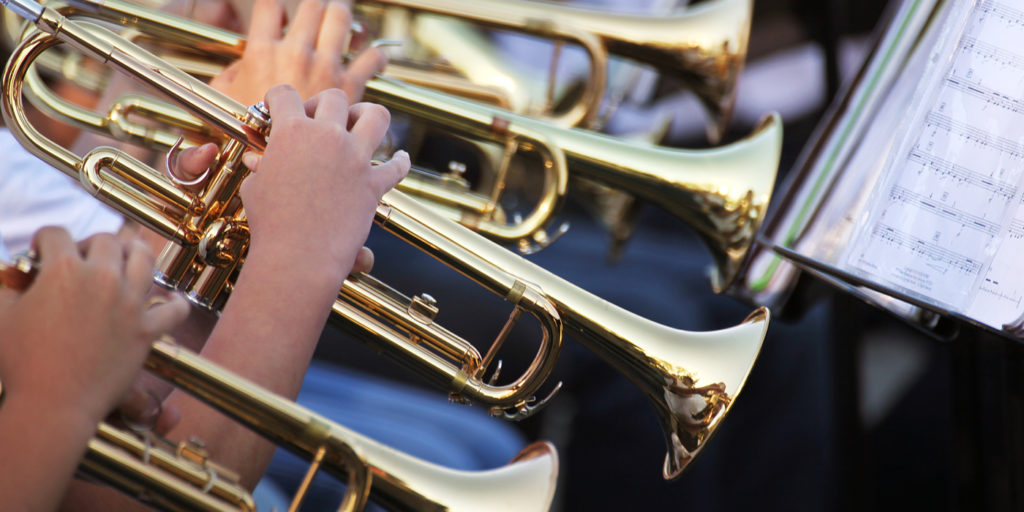
Any large ensemble director can relate to the feeling of having too much to do, and not enough time. Productive rehearsals require precise lesson planning. It can often be a challenge to touch on all the “problem spots.” In a large jazz ensemble, the director then has to attempt to make time to address improvisation, or hope that this is being thoroughly addressed in private study. However, it is possible to expose students to theory and ear training, and to teach style efficiently with some creative organization and modified rehearsal techniques.
Warm Up
In a wind band setting, it is common to warm up with chorales and scale exercises in the same key as works being rehearsed. This same practice can easily be adapted as a warmup for large jazz ensembles. Many charts come with “solo sheets” with chord changes for all instruments, and if these are not available, a traditional lead sheet can be distributed to the ensemble instead.
You can start rehearsal by having the band play “chorale” exercises, playing chord tones through the progression. These can be assigned to the whole ensemble in unison, by section, or if the group has developed their ears and theory knowledge enough, the individual can choose which chord tone they will play.
This exercise can be modified by having the band play the appropriate scale/mode over each chord in unison (unison pitch and rhythms). There is a wealth of material available that teaches chord/scale theory, such as Jamey Aebersold’s resources. In addition to a free “scale syllabus” available online, his Play-Along books provide lead sheets that visualize demonstrate appropriate scale choices over the chords. These can be useful in the event your band is playing a lot of traditional repertoire or standards available within the Aebersold series.
Tuning/Listening/Drones
Finding time to address ear training and listening can be difficult to do on a regular basis, so I advocate regularly combining this with the practice of isolating “trouble spots.” This works particularly well when working section soli passages.
I have had great success using tuning drones with my ensembles in rehearsal and in sectionals. I generally have sections play soli passages to a drone over the tonal center (tonic) of the piece. This serves two primary purposes: First, it helps the section ensure that they are playing in tune. (Drones provide overtones similar to playing in an ensemble and allow the student to “lock in” to the pitch, unlike an electronic tuner.)Secondly, it opens the students’ ears to start hearing how a given note relates to tonic.
This exercise will inevitably result in some “crunchy” intervals due to the chromatic nature of most jazz repertoire. This allows the student to embrace those sounds. It also helps them hear that dissonant upper extensions like b9’s and #11’s can be played in tune. I adapted this for large ensemble after watching jazz trumpeter Ingrid Jensen’s great video on YouTube where she discusses the use of drones in her individual practice. I highly recommend watching it and sharing with your students!
When one is dealing with a jazz transcription, an essential part of learning the improvised solo is playing along with the original recording, matching the soloist’s sound and inflections as closely as possible. This same technique can be applied to learning soli sections in large ensembles; assign students to play along with the original recordings of classic repertoire in individual practice or sectionals, and if time and the rehearsal space permits, visit this same exercise in rehearsal. This is an efficient manner to teach style, repertoire, and guide students to iconic recordings.
Sample of Rehearsal Strategies
Here are some specific rehearsal strategies using Count Basie’s “Blues in Hoss’ Flat”:
- Warm-up playing root of each chord over Db blues.
- Play through form again, with ensemble playing unison scale patterns (in this case, mixolydian over each chord).
- Isolate sax soli, with section playing solo over Db drone.
- Either in rehearsal or individual practice, have saxes play soli lines with Count Basie recording from “Chairman of the Board.”
- Isolate brass shout section; have brass play over Db drone, checking intonation and blend.
While you may not use all these concepts on every piece you are rehearsing, the above provides examples of ways in which you can quickly and creatively address ensemble issues.
Through the implementation of the above rehearsal techniques, it is possible to provide a warm-up, as well as address ensemble playing, improvisation, aural skills, theory, and historical recordings in a short amount of time. Most of the aforementioned can be utilized with modifications to traditional large ensemble rehearsal techniques, taking minimal additional rehearsal time. The spirit of these exercises is based in creativity, so I encourage you to experiment and modify for your ensemble. Most importantly, have fun doing it!